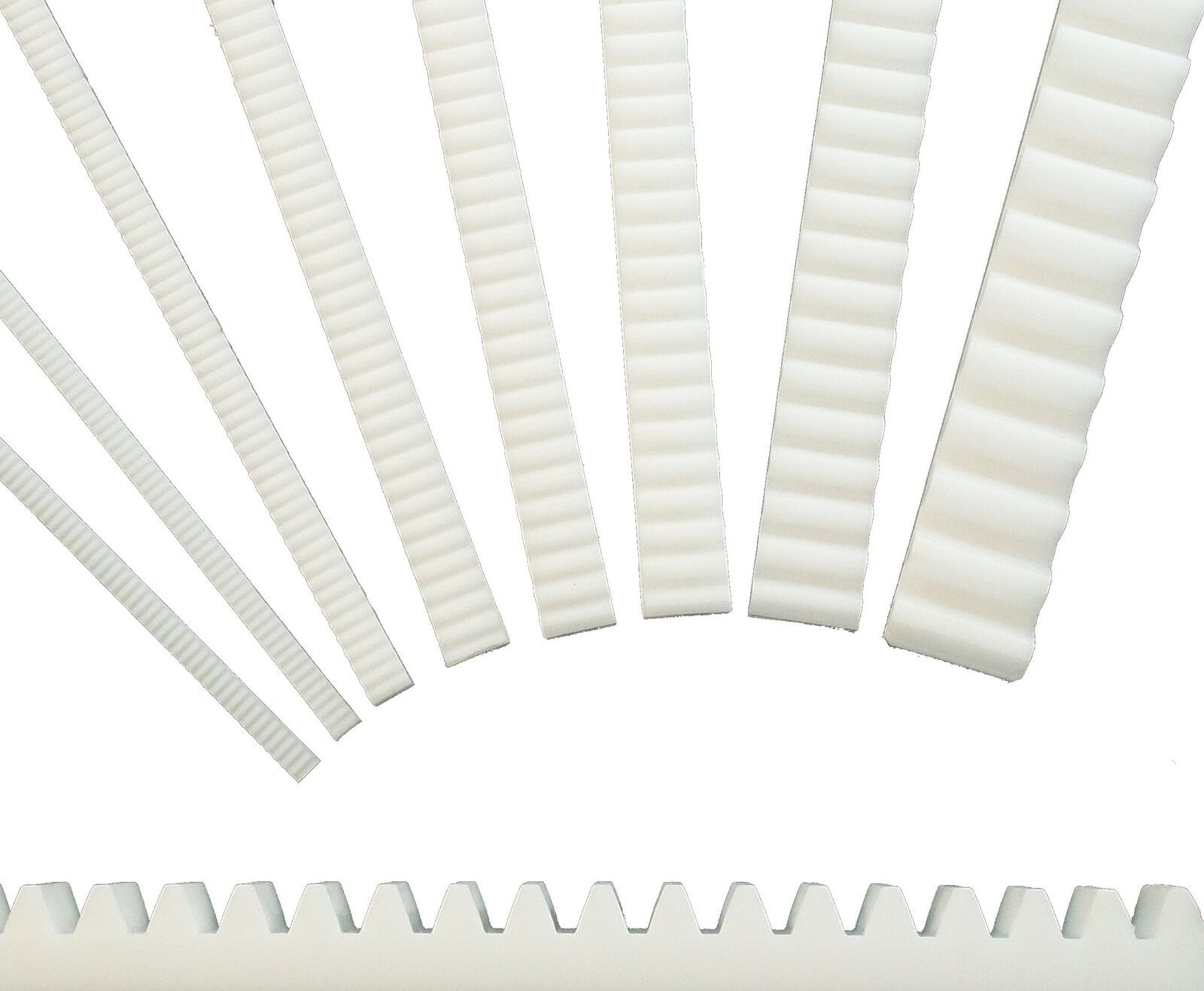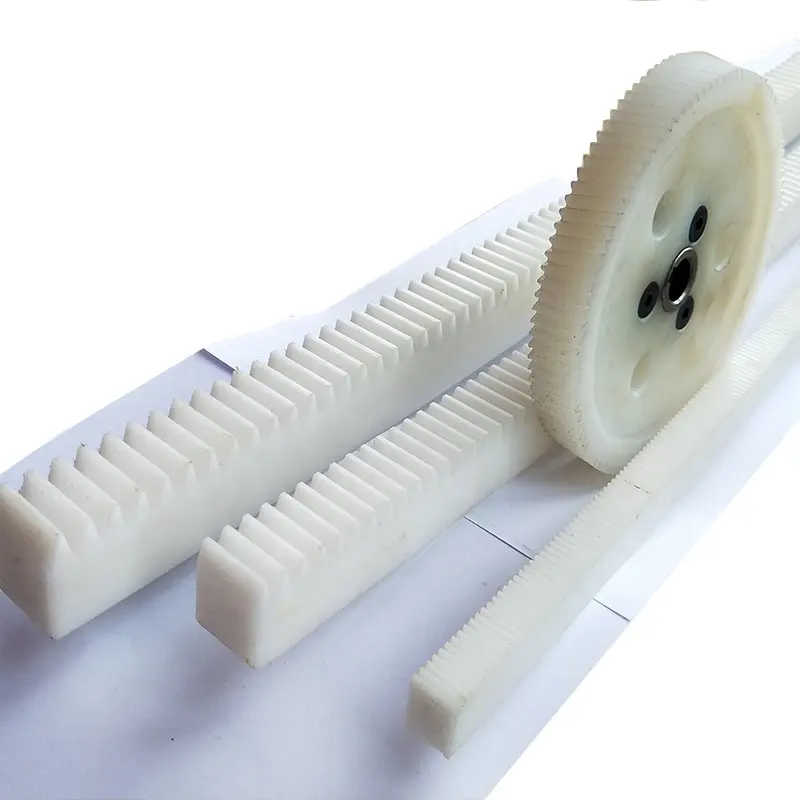Product Description
Product Description
Gear rack & pinion in modulus M1 M1.5 M2 M2.5 M3 M4 M5 M6 M8
| Product Name |
Gear Rack & Pinion |
| Modulus | M1, M1.5, M2, M2.5, M3, M4, M5, M6, M8 |
| Length | 500mm/1000mm/2000mm/3000mm |
|
Material |
Stainless steel SS304 ,Carbon steel C45, Aluminum , Nylon PA6 ect |
|
Treatment |
Black oxide, Electrogavanized, Teeth indutive hardened |
|
Hardness |
HRC 40-55 after teeth inductive hardened |
| Standard |
DIN, ANSI, JIS, BS, ISO |
|
Grade |
6 , 7 , 8, 9 |
| TYPE NO. | TYPE NO. |
|
M1 15X15X1000 |
M4 40X40X1000 |
| M1 15X15X2000 | M4 40X40X2000 |
| M1.5 17X17X1000 | M4 40X40X3000 |
| M1.5 17X17X2000 | M5 50X50X1000 |
| M2 20X20X1000 | M5 50X50X2000 |
| M2 20X20X2000 | M5 50X50X3000 |
| M2 20X20X3000 | M6 60X60X1000 |
| M2.5 25X25X1000 | M6 60X60X2000 |
| M2.5 25X25X2000 | M6 60X60X3000 |
| M2.5 25X25X3000 | M8 80X80X1000 |
| M3 30X30X1000 | M8 80X80X2000 |
| M3 30X30X2000 | M8 80X80X3000 |
| M3 30X30X3000 |
Detailed Photos
Catalogue
Workshop
Milling teeh Inspecting teeth
Packaging & Shipping
FAQ
Q1: Are you trading company or manufacturer ?
A: We are factory.
Q2: How long is your delivery time and shipment?
1.Sample Lead-times: 10-20 days.
2.Production Lead-times: 30-45 days after order confirmed.
Q3: What is your advantages?
1. The most competitive price and good quality.
2. Perfect technical engineers give you the best support.
3. OEM is available.
| Application: | Motor, Machinery, Agricultural Machinery |
|---|---|
| Hardness: | Hardened Tooth Surface |
| Toothed Portion Shape: | Spur Gear |
| Length: | 500mm/1000mm/2000mm/3000mm |
| Modulus: | M1 M1.5 M2 M2.5 M3 M4 M5 M6 M8 |
| Origin: | Zhejiang |
| Customization: |
Available
| Customized Request |
|---|

How do rack and pinion systems handle variations in load capacity and speed?
Rack and pinion systems are designed to handle variations in load capacity and speed effectively. Here’s a detailed explanation of how they handle these variations:
- Load Capacity: Rack and pinion systems can be designed to accommodate a wide range of load capacities. The load capacity primarily depends on the strength and size of the rack and pinion components, such as the rack material, tooth size, and pinion gear dimensions. By selecting appropriate materials and dimensions, rack and pinion systems can be optimized to handle varying load capacities. For higher load requirements, heavier-duty materials and larger gear sizes can be used to ensure sufficient strength and durability.
- Speed: Rack and pinion systems can also handle variations in speed. The speed of the system is influenced by factors such as the rotational speed of the pinion gear and the pitch of the rack. By adjusting these parameters, the speed of the system can be optimized to suit specific application requirements. For high-speed applications, rack and pinion systems can be designed with smaller pitch and lighter components to minimize inertia and allow for rapid acceleration and deceleration. On the other hand, for slower-speed applications, larger pitch and heavier components can be used to enhance stability and load-carrying capacity.
- Lubrication and Maintenance: Proper lubrication is crucial for the smooth operation and longevity of rack and pinion systems. Lubricants help reduce friction and wear between the rack and pinion gears, ensuring efficient power transmission and minimizing the risk of damage. The type and frequency of lubrication required may vary depending on the load capacity and speed of the system. Regular maintenance, including inspection and lubrication, is important to ensure optimal performance and longevity of the rack and pinion system under varying load and speed conditions.
- Design Considerations: When designing rack and pinion systems, it is essential to consider the anticipated load capacity and speed requirements. Factors such as gear material selection, tooth profile, gear module, and tooth width play a significant role in determining the system’s ability to handle variations in load and speed. The design should take into account the maximum expected load and speed to ensure that the rack and pinion components are appropriately sized and capable of withstanding the anticipated conditions.
- System Feedback and Control: In applications where load and speed variations are significant, incorporating system feedback and control mechanisms can enhance the performance of rack and pinion systems. Sensors and feedback devices can be used to monitor the load and speed, allowing for real-time adjustments and control. This feedback information can be utilized to implement closed-loop control systems that adjust the motor torque or speed to maintain precise motion control under varying load conditions.
By considering factors such as load capacity, speed, lubrication, maintenance, and design considerations, rack and pinion systems can effectively handle variations in load and speed, ensuring reliable and precise motion control in a wide range of applications.

Can rack and pinion systems be integrated into robotic and automation equipment?
Yes, rack and pinion systems can be successfully integrated into robotic and automation equipment to facilitate precise and efficient motion control. Here’s a detailed explanation of how rack and pinion systems can be utilized in robotic and automation applications:
Rack and pinion systems offer several advantages that make them well-suited for integration into robotic and automation equipment:
- Precision and Accuracy: Rack and pinion systems provide high precision and accuracy in motion control. The direct engagement between the pinion and the rack ensures a positive and backlash-free transfer of motion, allowing for precise positioning and repeatability. This characteristic is essential in robotic and automation applications that require accurate movement and positioning of components.
- High Speed and Acceleration: Rack and pinion systems are capable of operating at high speeds and accommodating rapid accelerations. The direct power transmission and efficient torque transfer of rack and pinion mechanisms enable quick and dynamic movements, making them suitable for applications that demand fast and agile robotic motions.
- Compact Design: Rack and pinion systems offer a compact design, which is advantageous in space-constrained robotic and automation setups. The linear nature of the rack allows for efficient integration into robotic arms, linear stages, and other motion control systems. This compact design maximizes the workspace utilization and allows for flexible placement of the rack and pinion mechanism.
- High Load Capacity: Rack and pinion systems can handle substantial loads while maintaining efficient power transmission. The engagement of the teeth provides a large contact area, allowing for the effective distribution of forces and torque. This characteristic is essential for robotic and automation equipment that needs to manipulate heavy payloads or exert significant forces.
- Versatility: Rack and pinion systems offer versatility in terms of design options and configuration possibilities. They can be implemented in various orientations, such as horizontal, vertical, or inclined setups, to accommodate different robotic and automation requirements. Additionally, rack and pinion systems can be combined with other mechanisms, such as gears and belts, to achieve complex motion profiles and multi-axis control.
- Reliability and Durability: Rack and pinion systems are known for their durability and long service life. When properly designed and maintained, they can withstand high loads, repetitive movements, and demanding operating conditions. This reliability is crucial in robotic and automation equipment, where continuous and uninterrupted operation is essential.
Overall, the integration of rack and pinion systems in robotic and automation equipment offers precise motion control, high-speed capability, compactness, load-handling capabilities, versatility, and reliability. These characteristics make rack and pinion systems a popular choice in applications such as pick-and-place robots, CNC machines, packaging equipment, material handling systems, and assembly lines.

In which industries are rack and pinion systems commonly used?
Rack and pinion systems are widely used in numerous industries due to their versatility, efficiency, and precise motion control. Here’s a detailed explanation of the industries where rack and pinion systems are commonly employed:
- Automotive Industry: Rack and pinion systems have extensive use in the automotive industry, particularly in steering mechanisms. They are commonly found in passenger cars, trucks, and other vehicles where they enable smooth and responsive steering control.
- Robotics and Automation: Rack and pinion systems play a vital role in robotics and automation. They are utilized in various robotic applications, including robotic arms, gantry systems, pick-and-place robots, and CNC machines. Rack and pinion systems provide accurate and controlled linear motion for precise positioning and manipulation in these industries.
- Industrial Machinery: Rack and pinion systems are commonly employed in industrial machinery and equipment. They are used in applications such as cutting machines, printing presses, packaging equipment, material handling systems, and more. The precise and efficient linear motion provided by rack and pinion systems enhances the performance and productivity of industrial machinery.
- Construction Industry: Rack and pinion systems are utilized in the construction industry for various applications. They are commonly found in construction equipment such as cranes, lifts, and scaffolding systems, where they enable controlled vertical movement and positioning.
- Medical Equipment: Rack and pinion systems are used in medical equipment for tasks that require precise linear motion control. They can be found in equipment such as medical imaging devices, surgical robots, patient positioning systems, and laboratory automation equipment.
- Aerospace and Defense: Rack and pinion systems are employed in the aerospace and defense industries for various applications. They are used in aircraft control mechanisms, satellite systems, missile guidance systems, and other aerospace and defense equipment that require accurate and reliable linear motion control.
- Entertainment Industry: Rack and pinion systems find applications in the entertainment industry, particularly in stage and theater setups. They are used for moving stage elements, lighting fixtures, and other equipment to create dynamic and precise movements during performances.
- Other Industries: Rack and pinion systems are also utilized in other industries, including agriculture, energy, manufacturing, and more. They find applications in equipment such as agricultural machinery, solar tracking systems, industrial automation, and specialized machinery.
Rack and pinion systems offer a versatile and efficient solution for converting rotational motion into linear motion, making them valuable in a wide range of industries that require precise motion control, reliability, and compact design.


editor by CX 2023-10-08